Angela Ackerman's Blog: Writers Helping Writers, page 46
September 3, 2022
Fear Thesaurus Entry: Not Being Believed
Debilitating fears are a problem for everyone, an unfortunate part of the human experience. Whether they’re a result of learned behavior as a child, are related to a mental health condition, or stem from a past wounding event, these fears influence a character’s behaviors, habits, beliefs, and personality traits. The compulsion to avoid what they fear will drive characters away from certain people, events, and situations and hold them back in life.
In your story, this primary fear (or group of fears) will constantly challenge the goal the character is pursuing, tempting them to retreat, settle, and give up on what they want most. Because this fear must be addressed for them to achieve success, balance, and fulfillment, it plays a pivotal part in both character arc and the overall story.
This thesaurus explores the various fears that might be plaguing your character. Use it to understand and utilize fears to fully develop your characters and steer them through their story arc. Please note that this isn’t a self-diagnosis tool. Fears are common in the real world, and while we may at times share similar tendencies as characters, the entry below is for fiction writing purposes only.
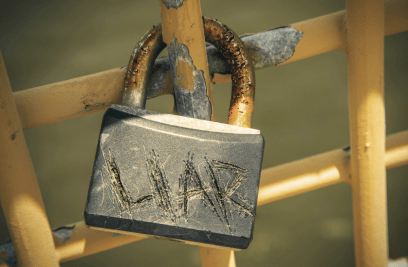 Not Being Believed
Not Being BelievedNotes
The fear of not being believed often comes from a place of abuse. A character who made themselves vulnerable to someone (a relative, a corporation, the media, etc.) and was then accused of dishonesty, unreliability, or worse���it’s enough to turn that character into a bubbling mess of self-doubt and paranoia. There is nothing like an abuse of power to send one spiraling into a dark abyss that takes years to climb out of.
What It Looks Like
Only telling people what the character thinks they want to hear
Only speaking up when there is zero doubt that what the character is saying is true
Being loose with the truth (because no one will believe them anyway)
Being honest to a fault���refusing to tell even a little white lie
Needing constant assurance that people believe them
Withdrawing from friends and family
Questioning everything that is said or presented to them
Being able to read others and recognize dishonesty
The character often accusing people of lying to them or to loved ones
Becoming angry if their word is questioned
Searching for the truth in all things
The character having nightmares about times when they weren’t believed
Keeping quiet about abuse or unfairness (because speaking up won’t do them any good)
Harboring a healthy distrust of other people, institutions, etc.
Extreme self-reliance from the belief that the character can trust no one but themselves
Common Internal Struggles
Wanting to speak up about an injustice but worrying they won’t be believed
Feeling guilt or shame despite having done nothing wrong
Being paranoid that people are conspiring against them
Wanting to confide in someone but being unsure if they’re trustworthy
Wanting to speak up about a situation but choosing not to after seeing society’s reaction to a similar event
The character second-guessing themselves, doubting their ability to remember details correctly
Negative self-talk (berating themselves for not standing up for themselves, etc.)
Hindrances and Disruptions to the Character’s Life
Living in isolation
Struggling professionally due to a distrust of those in authority
Being ruled by fear or anger
Quitting jobs rather than telling someone about workplace injustices
Difficulty relating to or accepting people who are similar to those who didn’t believe the character (men, women, police officers, doctors, religious leaders, etc.)
Living with self-doubt because the character doesn’t trust their own instincts
Never knowing who can be trusted
Continuing in a toxic or harmful situation because the character thinks no one will believe them
Scenarios That Might Awaken This Fear
Watching someone go public with a similar problem and lose all credibility in the media
Witnessing behavior at work that should be reported
The character testifying about a crime and their word being questioned
Seeing someone speak out about what happened to them and hearing loved ones blame the victim
Being told by an abuser and that no one will believe the character if they talk
Telling authorities about wrongdoing and seeing nothing happen
Innocently witnessing a crime and being named as a suspect
Being told about an injustice in a way that makes the character question the reporter
Other Fear Thesaurus entries can be found here.
 Need More Descriptive Help?
Need More Descriptive Help?While this thesaurus is still being developed, the rest of our descriptive collection (16 unique thesauri and growing) is accessible through the One Stop for Writers THESAURUS database.
If you like, swing by and check out the video walkthrough for this site, and then give our Free Trial a spin.
The post Fear Thesaurus Entry: Not Being Believed appeared first on WRITERS HELPING WRITERS��.
August 31, 2022
Writing Goals: Seven Ways to Ensure You Reach Them

By Jordan Kantey
The joy of having finished a draft is one of writing���s great pleasures, yet to get there, you need to set – and find ways to keep – writing goals. Here are seven ideas to build accountability and ensure small wins keep rolling:
1.��Build Small Habits for Replicable WinsIn the book, Atomic Habits (2018), James Clear writes about how easy it is to think about your goals in terms of major actions rather than the small improvements you can make on a daily basis. His thesis is that small habits established over time become big wins.
Romance novelist, RITA award nominee and Now Novel writing coach Romy Sommer often tells an anecdote in our writing webinars about small habits. When she wrote her first novel she would write snippets in stolen fifteen minutes and half hours while parked in her car, waiting on the school run.
Where in your day can you carve out time and attach writing to something you have to do anyway? How else can you build writing habits that start small but lead to big wins? Keep reading for ideas:
2.��Attach Writing to Things You Do by DefaultSmall, replicable wins – such as writing 500 words daily, to begin – help writing become almost unconscious, like a pianist���s muscle memory. In time, you find the keys without thinking.
One way to make goal-keeping almost automatic is to ���stack��� habits. This is something theorized by Stanford behavioral scientist BJ Fogg, who suggests using habitual behaviors as triggers for what you want to achieve.
Fogg gives the formula for building a habit you can keep. ���After I do X, I will do easy-win-Y���. For example, ���After I start my morning coffee, I will tidy one item in the living room���.
The small, attainable step also brings the higher-effort step closer. For example, as Romy Sommer says regarding ���stretch goals���:
���When you sit down to write, decide how many words you’ll be happy to write, and how many words you’ll be really happy to write. Maybe you’ll be okay with writing 300 words in an hour and ecstatic if you reach your stretch goal of 500 words. This way, when you achieve the lower goal, you’ll still feel that the session was a success – and more often than not, by reducing the pressure and performance anxiety from aiming for the higher goal, you’ll actually achieve that stretch goal!���
3.��Find Accountability PartnersWhat is an accountability partner? Someone who shows up when you���re supposed to, checks in, and understands – or even better shares – your goals.
Writing sprints are one kind of accountability tool to ensure you keep showing up to write.
Members of Now Novel���s Group Coaching program often say our daily virtual writing sprints (where members meet in a LiveWebinar room on the hour and write without talking) are a helpful tool for sticking to writing goals and structuring writing time.
Accountability partners are also great because:
In one writing webinar on process, Romy shared a simple yet effective tip for staying focused on your writing goals:
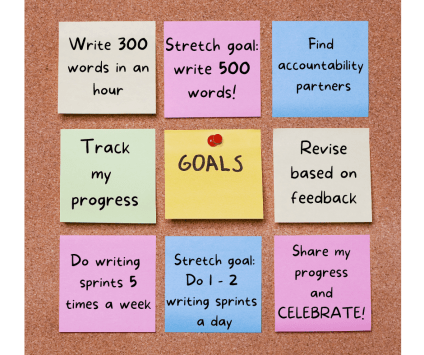
Write a SMART (specific, measurable, attainable, realistic and time-based) goal in a fun design and save it as your phone or desktop background (you could use a free graphic design tool such as Canva).
If you often check your devices, it���s an easy way to fill each day with small reminders of attainable (not massive) actions that support your writing goals.
5.��Write And Rewrite to Learn Your Ideal Writing Process
Remember how ���massive action��� isn���t necessary to reach your goals? Perspective comes with writing a lot and learning that a first draft is almost never the final draft.
Finishing the first run of a manuscript may feel like massive action qualitatively. Yet drafting plus rewrites (with beta reader or editorial input) can take you from something good (and attaining your first goal, completion) to something great – a well-developed story.
6.��Stay Open to Revising Your Writing GoalsYou only truly learn the actions your goals require by doing and finding out what works for you.
Sometimes you need to revise your timelines due to your preferred process, and that���s OK. Stanford did a study of 1.4 million weight loss app users and found that behaviors in the first week of forming new habits massively influence whether you will stay the course and reach your goals.
This is part of why we conduct an intake call in the first week of our Group Coaching author program – we get to understand each member���s goals better, and often spot any challenges that may necessitate small adjustments to process and expectations.
Revisiting your writing goals and adjusting your timeline expectations if necessary keeps writing from becoming a source of pressure more than pleasure.
7.��Journal and Share ProgressJournaling is a powerful tool for self-reporting your feelings, process and progress. Touching base with your aspirations and any attendant fears.
Writing coaches and constructive, caring critique circles function similarly to journaling in helping you stay focused on your writing goals while touching base. They provide a mirror in which you may measure where you were then vs where you are now.
Sharing doubts, writing challenges and conundrums in a supportive environment is a lot like journaling because you have the feedback that helps you remember (and renew commitment to) your goals.
To sum up, writing goals are easier to reach when you build small habits and attach writing to habits you���ve built already. Finding accountability partners and joining writing sprints provides camaraderie and supports building good habits. Keep writing to learn what works for you, and rewrite ten times if you need to, journaling your process or sharing with a critique circle if you find this boosts your focus and motivation.

Now Novel���s Group Coaching author program provides a structured curriculum to write a book in six months. As a member, you get daily writing sprints to help you stay accountable to your goals, weekly workbooks on writing craft and Q&As with experienced writing coaches, personal feedback on your work and regular live webinars on craft, genre and process, plus weekly feedback in small critique groups and story outlining tools. Everything you need to finish a book with structured support, in a writing community that cares. Visit Now Novel to see what alumni loved and learn more.

Jordan Kantey is a fiction editor, copywriter and blogger who writes the Now Novel blog and performs manuscript assessments. Now Novel has been helping authors improve their craft since 2010 with personalized help from published writers and offers author coaching and editing services, short courses, story outlining tools and a critique community where members write more, together. Follow Now Novel on��Instagram,��Facebook,��Twitter��and��YouTube��for writing tips, prompts, contests and more.��
The post Writing Goals: Seven Ways to Ensure You Reach Them appeared first on WRITERS HELPING WRITERS��.
August 30, 2022
A Look Inside The Conflict Thesaurus SILVER Edition
In the past when we’ve released a 2-volume set, it’s always been at the same time, but with the Conflict Thesaurus, life was just too busy to try and do two books at once. We are ecstatic to finally have both out in the world. Let’s take a look at what’s inside the second volume.
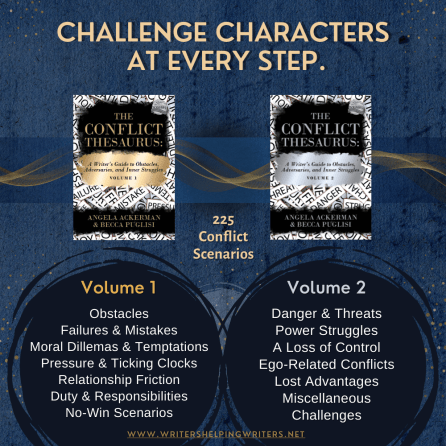
The Conflict Thesaurus GOLD edition (Volume 1) served up a smorgasbord of conflict scenarios that would challenge, strain, and reshape a character into who they must become to win.
This SILVER edition (Volume 2) offers yet more problems, challenges, and points of friction, so we thought you might like to read through some of them and how they create minor inconveniences or disastrous fallout depending on what your story needs:
Being Injured
Experiencing Discrimination
Losing a Vital Item
Telling the Truth but Not Being Believed
Being Trapped
Having Unwanted Powers
(To see the entire list of 115 conflict scenarios, go here.)
This SILVER guide also delves into more ways conflict can be used to power your story, so get ready to level up your plotting skills so every event in your story pushes the story forward and deepens tension.
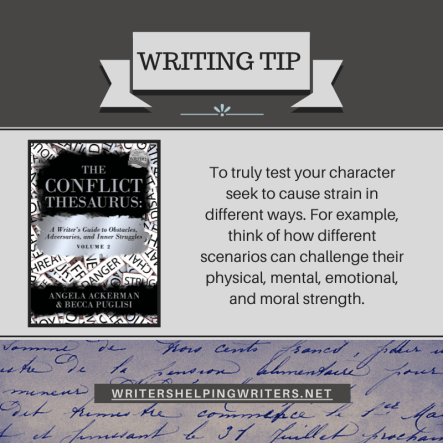 What writers are saying about this guide…
What writers are saying about this guide…“Angela and Becca did such an amazing job of laying these two books out, they are literal compliments to each other. If you read one, I guarantee you will become obsessed with reading the other. It is like finally resolving the cliffhanger that left you craving more.” ~ Vincent Jobson
“Volume 2 of The Conflict Thesaurus series is a gold mine. A wealth of information you absolutely have to have in your writing craft library.” ~ Tara Baisden
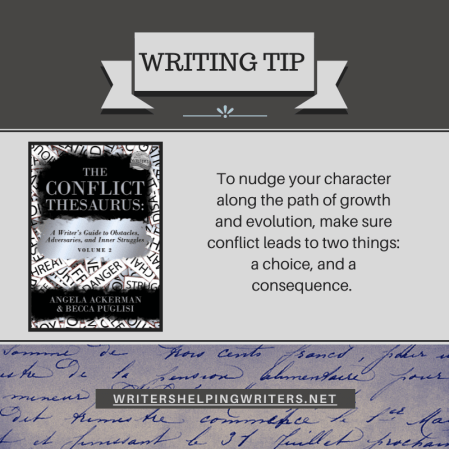
“Volume 2 of The Conflict Thesaurus: A Writer���s Guide to Obstacles, Adversaries, and Inner Struggles is a tool that I have no hesitation in calling indispensable. It���s a book that you can crack the cover and immediately start using in either creating a new story or working on a current one.” ~ Nichole Squire
“Not only is the new material insightful, but when going through the book, I found my mind jumping to my current WIP (work-in-progress) as well as roughly plotting future books with ideas brimming to the surface, all saying, Write me. No, write me first.” ~ Kathy
Add the book to your Goodreads list and see the reviews
See the master list of entries
Buy the book in print and ebook or PDF formats
Check out The Conflict Thesaurus Volume 1
Do you enjoy writing conflict and consider it an area of strength for you? Let us know in the comments!
The post A Look Inside The Conflict Thesaurus SILVER Edition appeared first on WRITERS HELPING WRITERS��.
Sneak-a-Peek at The Conflict Thesaurus SILVER Edition
We have a book launch right around the corner: September 6th, and this one is a bit special as it’s the first time we’ve had a two-volume thesaurus that was a staggered release. Needless to say, we’re excited to bring these two together at last, and for you to see the second volume!

The Conflict Thesaurus GOLD edition (Volume 1) served up a smorgasbord of conflict scenarios that would challenge, strain, and reshape a character into who they must become to win.
This SILVER edition (Volume 2) offers yet more problems, challenges, and points of friction, so we thought you might like to get an early look at some of them and how they create minor inconveniences or disastrous fallout depending on what your story needs:
Being Injured
Experiencing Discrimination
Losing a Vital Item
Telling the Truth but Not Being Believed
Being Trapped
Having Unwanted Powers
(To see the entire list of 115 conflict scenarios, go here.)
This SILVER guide also delves into more ways conflict can be used to power your story, so get ready to level up your plotting skills so every event in your story pushes the story forward and deepens tension.
 What writers are saying about this guide…
What writers are saying about this guide…“Angela and Becca did such an amazing job of laying these two books out, they are literal compliments to each other. If you read one, I guarantee you will become obsessed with reading the other. It is like finally resolving the cliffhanger that left you craving more.” ~ Vincent Jobson
“Volume 2 of The Conflict Thesaurus series is a gold mine. A wealth of information you absolutely have to have in your writing craft library.” ~ Tara Baisden

“Volume 2 of The Conflict Thesaurus: A Writer���s Guide to Obstacles, Adversaries, and Inner Struggles is a tool that I have no hesitation in calling indispensable. It���s a book that you can crack the cover and immediately start using in either creating a new story or working on a current one.” ~ Nichole Squire
“Not only is the new material insightful, but when going through the book, I found my mind jumping to my current WIP (work-in-progress) as well as roughly plotting future books with ideas brimming to the surface, all saying, Write me. No, write me first.” ~ Kathy
Read more reviews at Goodreads
We’re looking forward to having both these volumes out in the world, and hope you are, too. Make sure to join us on September 6th for our book release — we’ve got a few things in store we think you’ll like!
Do you enjoy writing conflict and consider it an area of strength for you? Let us know in the comments!
The post Sneak-a-Peek at The Conflict Thesaurus SILVER Edition appeared first on WRITERS HELPING WRITERS��.
August 27, 2022
Fear Thesaurus Entry: Death
Debilitating fears are a problem for everyone, an unfortunate part of the human experience. Whether they’re a result of learned behavior as a child, are related to a mental health condition, or stem from a past wounding event, these fears influence a character’s behaviors, habits, beliefs, and personality traits. The compulsion to avoid what they fear will drive characters away from certain people, events, and situations and hold them back in life.
In your story, this primary fear (or group of fears) will constantly challenge the goal the character is pursuing, tempting them to retreat, settle, and give up on what they want most. Because this fear must be addressed for them to achieve success, balance, and fulfillment, it plays a pivotal part in both character arc and the overall story.
This thesaurus explores the various fears that might be plaguing your character. Use it to understand and utilize fears to fully develop your characters and steer them through their story arc. Please note that this isn’t a self-diagnosis tool. Fears are common in the real world, and while we may at times share similar tendencies as characters, the entry below is for fiction writing purposes only.
 Fear of Death
Fear of DeathNotes
Human beings have a natural drive for self-preservation and survival, so a healthy respect for death is normal. But when the character begins to obsessively fear that they or a loved one will die, a phobia called thanatophobia can develop. Someone in this situation may be afraid of the death process���of pain, the unknown, or the afterlife���or simply of ceasing to exist. This kind of fear can dominate a person’s life, making it impossible for them to enjoy even the smallest aspects of living.
What It Looks Like
Shying away from potentially dangerous or thrill-seeking situations (skydiving, storm chasing, running at night, etc.)
Frequently checking for signs of illness or disease
Avoiding cemeteries, funeral homes, and other places associated with death
Not celebrating Halloween, the Day of the Dead, and other holidays related to death
Checking in frequently on loved ones to make sure they’re okay
Taking vitamins and supplements
Exercising obsessively
Insisting on over-the-top safety precautions
Avoiding hospitals
Running to the doctor at the slightest sign of illness
Protecting children to the point of smothering them
Being an overly cautious driver
Being overly concerned about germs
Doing good deeds as a way of “balancing the scales” in this life so the character won’t be punished in the next one
Talking incessantly about reports of dangerous places, mass casualty events, etc.
Making fear-based decisions
Suffering from frequent nightmares or insomnia
Common Internal Struggles
The character falling sick and fretting that they’ve contracted a deadly disease��
Worrying that they won’t be able to accomplish everything they want to before they die
Anxiety rising when the character sees a news report about someone dying
Desperately wanting to know the truth about the afterlife but not having any proof
Struggling to act normal because the character knows their fear makes them look irrational
Not being able to rest when loved ones are away
Knowing the character’s actions are driving family members away but being unable to lighten up
Obsessing over exercising regularly and eating healthy
Struggling with paranoia
Flaws That May Emerge
Fussy, Controlling, Morbid, Needy, Obsessive, Paranoid, Stubborn, Worrywart
Hindrances and Disruptions to the Character’s Life
Missing out on opportunities to try new things
Being reclusive and living a life of isolation
The character’s health being such a big priority that they don’t have time for other activities
Other people avoiding the character because of their neediness, restrictive rules, and obsessive need for safety��
Having to use medication to control anxiety and depression
Spending so much time worrying about death that the character loses all joy and happiness
Being ruled by fear
Scenarios That Might Awaken This Fear
Experiencing a life-threatening situation, such as a car accident or a tropical storm
The character or their loved one being diagnosed with a terminal illness
A loved one dying unexpectedly
Having to attend a funeral
Seeing death depicted in a movie or on the news
Having a near-death experience��
Suffering a serious injury
Milestone birthdays that represent the passage of time
Seeing signs of aging as the character gets older
Other Fear Thesaurus entries can be found here.
 Need More Descriptive Help?
Need More Descriptive Help?While this thesaurus is still being developed, the rest of our descriptive collection (16 unique thesauri and growing) is accessible through the One Stop for Writers THESAURUS database.
If you like, swing by and check out the video walkthrough for this site, and then give our Free Trial a spin.
The post Fear Thesaurus Entry: Death appeared first on WRITERS HELPING WRITERS��.
August 24, 2022
Use Conflict to Target a Character’s Soft Spots

Conflict is a key story ingredient, one we need a lot of, but this doesn’t mean quantity is better than quality. Fiction isn���t a video game; waves of bad guys with guns won’t keep readers tuned in for long. They expect to see a variety of conflict, including meaningful problems that deepen the story, raise the stakes, advance the plot, and provide opportunities for character development.
This last one is especially important, as it’s how a beloved character responds to adversity that really draws readers in.
The best way to reveal characterization and development is to use conflict to target our character’s soft spots. When we take aim at the things our character cares most about, trigger their fears or insecurities, or smack them right in the ego, they’ll react in a way that reveals their true selves, and that’s the person readers will connect to.
So, how do we find the right problems and challenges that will produce the response we’re looking for?It’s true, there is no end to the ways you can challenge your character. And I don’t know about you, but sometimes having too much choice can be paralyzing.
Something Becca and I did to help with this was to create categories for conflict by looking at the theme that a clash would produce.
We covered some of these categories (and the scenarios that go with each), in The Conflict Thesaurus, Volume 1:
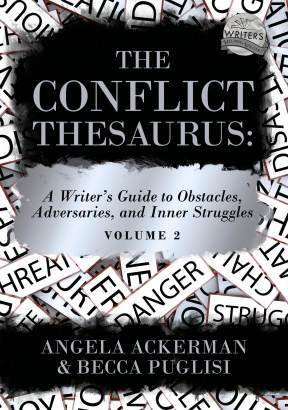
And the remainder of these categories are in The Conflict Thesaurus Volume 2, releasing September 6th.
Let’s look at each category’s superpowers so you can better decide what type of conflict serves your story and will challenge characters in the way you need most.
Dangers and ThreatsThis is a versatile form of conflict: a hazard or menace that represents direct harm to the character or the people they care about (and may be responsible for). Introducing a danger or threat can mess with your character���s mental state, pulling up their deepest fears and even leading to panic if others they love are at risk.

Danger can originate from other people, the environment, a location, or even from within the character themselves. For someone struggling with an addiction, an inability to gauge risk or seek help could lead to a hospitalization or death. A person consumed with guilt over past mistakes might become self-destructive, taking on an adversary or challenge far beyond their abilities because they believe that only self-punishment or self-sacrifice can balance the scales.
Another terrific place to find danger is in the setting. Look at where your character is, and the natural dangers lurking in the area: will the rain-soaked ground where your adventurers are hiding give way, or will a poisonous centipede skitter into a character���s sleeping bag on a camping trip? Will that neighbor show up before your character has time to clean up a murder scene? Depending on what you need for the story, threats or dangers can inconvenience, create delays, ruin carefully laid plans, or worse.
Ego-Related ConflictsIn the real world, people tend to shy away from situations where they could be embarrassed because they worry about what others think and don���t like to be judged. Insecurities magnify mistakes in their minds, especially if their egos have been hurt by criticism or similar blunders in the past.

Because well-built characters will have similar psychological drivers, they’ll struggle with some insecurities, too. Being excluded, discredited, blamed, or minimized will hurt them, even if they strive not to show it.
Ego-related challenges stir up internal conflict and trigger sensitivities that are hard to hide, so the character may respond by pulling back and isolating themselves, exploding with anger, or replying with barbed honesty that only makes things worse.
Consider Fiona, our protagonist who has not visited her hometown in quite a while. Things are becoming serious with her boyfriend, however, so she books a flight. She’s nervous, because her parents have some odd ideas about the world, but she knows Drew is the one, and it���s time to introduce him to her family.
Fiona and Drew arrive as her parents are having an after-dinner glass of port. At first, everything goes as expected. They’re overjoyed at the surprise visit and they fawn over Drew, asking about his job, family, interests���basically ticking all the boxes. But as one glass of port turns into several, Fiona’s dad begins to rant a bit about world events until, in a pin-drop moment, he floats a full-on, dark net alien conspiracy theory.
Imagine Fiona���s embarrassment and how she might try to salvage the evening. Maybe she laughs it off, pretending it���s a joke. Or she tells Drew that her dad���s teasing him to see how he���ll react. But the more Fiona tries to minimize the damage, the louder and more verbal her father gets. Soon he���s targeting Fiona, criticizing her for being naive, living in a dream world, and not acknowledging the indisputable evidence that an alien force is pulling the puppet strings of the human race. As her father rages, humiliation washes over her. The love of her life is bearing witness to this lunacy. What must Drew think of her parents���and her?
Ego-related conflict–such as suffering a humiliation like Fiona–strikes deep. It will hurt and lead to internal struggles regarding self-esteem, so if your character is traversing a change arc, depending on how they handle the situation, it can help them move forward, or set them back.
A Loss of ControlIn the real world, the need to control outcomes control steers decision-making. We may invest in a university degree to secure a higher-paying job, or buy a house in a school district that ensures our children get a quality education. We put fuel in the car so we don���t run out, clean scraped knees so they don���t get infected, and choose politeness over honesty to avoid drama. In other words, we live according to the rules of cause and effect.

But does life give two crab apples about cause and effect? Nope. While we���re playing the odds, it stands up and says, ���Hold my beer.��� It���s indisputable and somewhat horrifying: control is only an illusion. At any moment, something unexpected can happen that undoes all our careful planning.
A loss of control in the real world can be devastating because we think we should have seen what was coming���anticipated it and had an escape plan ready, so when we hit a character with a complication they can���t stop or prevent, it messes them up, too.
Conflicts that dispel the myth of control will reveal characterization in the protagonist’s lowest moment. Imagine a character whose spouse succumbs to a heart attack while camping. In the days that follow, does our grieving character angrily push people away, causing cracks to surface in those relationships? Does he sink into the quicksand of denial and refuse to acknowledge what happened? Or will he set aside his pain to help his children and other family members cope with their heartbreaking loss?
A loss of control will also give your readers a queasy-familiar sensation because they too have experienced moments where they thought they had a handle on things but didn���t. So if you want pull readers in or create empathy for a character, this is a great way to do it.
Losing an AdvantageOne of the worst things we can do to a character is cause them to lose hope. After all, conflict���s sharp sword has already jabbed them relentlessly throughout the story. They���ve fought, sacrificed, and clawed their way forward, and then finally, their hard work starts to pay off. They gain something they need, the world starts to support them, or they pull ahead of the competition.
So naturally, because we���re evil, we take their hard-won advantage away.
Losing an advantage is a versatile type of conflict that can be especially helpful at specific times, so it should be wielded strategically. For example, not every character rushes out the door when the trumpet of adventure sounds. Instead, they cling to their favorite saggy, cat-clawed chair, because even if the living room of life isn���t great right now, it���s what they know, and that makes it safe. It’s in their comfort zone.
But if we let our characters stay where they are, the story is as good as dead. Taking away something they deem vital, like a position of authority, a trusted ally, or cherished relationship, can convince them to stumble through that first story door.
This type of conflict can also test a character’s commitment. What happens when they lose the one thing that���s been motivating them to continue? If their lead witness in a trial is murdered, or their benefactor withdraws support, or an adoption falls through, will they forge ahead or throw in the towel?
Power Struggles
If there���s one thing we know about our characters, it���s that at some point, they’re going to clash. And why is no mystery. Each member of our story���s cast has their own goals, agendas, needs, and beliefs, and those don���t always play nicely with the goals, agendas, needs, and beliefs of others. When there���s too much friction, a power struggle ensues.
This often happens in relationships where characters don���t have equal status, such as a police officer and suspect, boss and employee, or teacher and student. It can occur when the person with less power tries to level the playing field or unseat the other party. Conflict will also arise when it���s perceived that one person is using their position unfairly. If your character is on the receiving end of a power play���say, they’ve been frivolously sued by a disgruntled customer, falsely accused by a rival, or passed over for promotion because of nepotism���it will trigger their moral sense of right and wrong, leading to a battle royale.
One of the best places to highlight a power struggle is within a dialogue exchange between characters with different goals. If one party wants information the other doesn’t want to share, a beautiful tug-of-war can unfold, complete with verbal jabs, veiled threats, and insults.
Miscellaneous ChallengesConflict is multifaceted, and like most things in life, not every scenario can be filed neatly into a particular box. If you���re searching for conflict that provides a unique challenge for your character or complicates their situation in ways you might not have considered, this is the category for you. Maybe your character is in the wrong place at the wrong time, they have been mistaken for someone else, or a dire circumstance forces them to blindly trust a stranger. Oh, the possibilities!
Want to see the conflict scenarios listed in each category? Find them here.
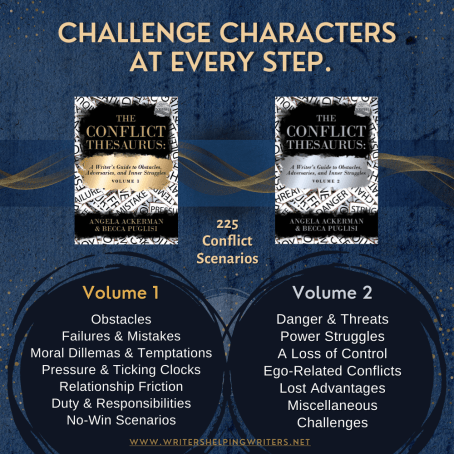
When conflict is thoughtfully chosen, everything clicks into place. Problems, challenges, and blockers raise the stakes, intensify the plot, and force the character to confront their own inner demons and shortcomings because only through growth, the ability to adapt, and hard work will they stay ahead of disaster.
The Conflict Thesaurus: A Writer’s Guide to Obstacles, Adversaries, and Inner Struggles (Volume 2) will be here soon! Find out more about this guide, sign up for a notification when this book releases, or add the book to your Goodreads list and read early reviews.
The post Use Conflict to Target a Character’s Soft Spots appeared first on WRITERS HELPING WRITERS��.
August 22, 2022
Phenomenal First Pages Contest – Guest Editor Edition
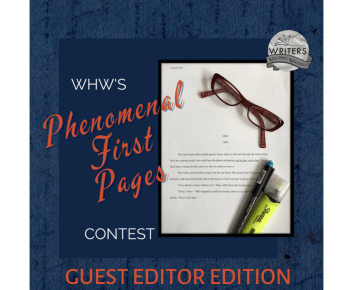 Hey, wonderful writerly people! It���s time for our monthly first-page critique contest! This month, winners will receive feedback from a professional editor. So exciting!
Hey, wonderful writerly people! It���s time for our monthly first-page critique contest! This month, winners will receive feedback from a professional editor. So exciting! 
If you���re working on a first page and would like some objective feedback, please leave a comment. Any comment :). As long as the email address associated with your WordPress account/comment profile is up-to-date, I���ll be able to contact you if your first page is chosen. Just please know that if I���m unable to get in touch with you through that address, you���ll have to forfeit your win.
*Genres NOT included in this month’s contest: heavy fantasy or sci-fi, mystery, horror, children���s & nonfiction. Please note any content warnings in your work (violence, gore, abuse, sexual assault, etc.).
Here’s the editor you’ll be working with:
Emily Ohanjanians is a professional fiction editor with over 15 years��� experience in publishing. She has acquired, edited and published novels for big publishers like Harlequin and HarperCollins, ranging from debuts to New York Times bestsellers. Her portfolio spans many genres, including book-club fiction, women���s fiction, contemporary romance, romantic comedy, humor fiction, suspense and thrillers, historical and speculative fiction.
She loves the process of helping writers shape their stories, and offers a wide range of editing services, including editorial assessments, developmental edits, line edits, query & submission package reviews. Visit www.emilyohanjanians.com for more details about her services, books she���s edited and testimonials, and to contact Emily directly. She���d love to hear from you!
Contest GuidelinesThis month���s contest will work the same as it usually does���except our amazing guest editor will be the one sending feedback if you win.Please be sure your first page��(double-spaced in 12-point font)��is ready to go so Emily can critique it before next month���s contest��rolls around.��If��it needs some work��and you won���t be able to get it to me right away, please plan on entering��the next contest, once any necessary tweaking has been taken care of. This contest only runs for 24 hours, start to finish, so get your comment in there!Three commenters��� names will be randomly drawn and posted tomorrow morning. If you win, I’ll contact you with information about sending it to me. Then, I’ll forward it to Emily for feedback.
We run this contest on a monthly basis, so if you���d like to be notified when the next opportunity comes around, consider subscribing to our blog (see the right-hand sidebar).
Good luck! I can’t wait to see who the winners will be. 
If you want to amp up your first page, grab our helpful��First Pages checklist from One Stop for Writers. And for more instruction on these important opening elements, see this��Mother Lode of First Page Resources.
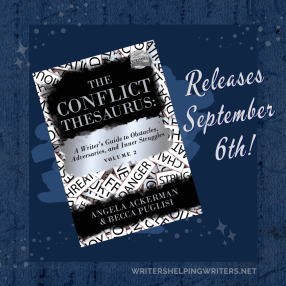 The 2nd volume of��The Conflict Thesaurus: A Writer’s Guide to Obstacles, Adversaries, and Inner Struggles��is releasing in just a few weeks. Check back on September 6th to see the fabulous prizes we’re giving away with this launch!
The 2nd volume of��The Conflict Thesaurus: A Writer’s Guide to Obstacles, Adversaries, and Inner Struggles��is releasing in just a few weeks. Check back on September 6th to see the fabulous prizes we’re giving away with this launch!The post Phenomenal First Pages Contest – Guest Editor Edition appeared first on WRITERS HELPING WRITERS��.
August 20, 2022
Fear Thesaurus Entry: Losing Autonomy
Debilitating fears are a problem for everyone, an unfortunate part of the human experience. Whether they’re a result of learned behavior as a child, are related to a mental health condition, or stem from a past wounding event, these fears influence a character’s behaviors, habits, beliefs, and personality traits. The compulsion to avoid what they fear will drive characters away from certain people, events, and situations and hold them back in life.
In your story, this primary fear (or group of fears) will constantly challenge the goal the character is pursuing, tempting them to retreat, settle, and give up on what they want most. Because this fear must be addressed for them to achieve success, balance, and fulfillment, it plays a pivotal part in both character arc and the overall story.
This thesaurus explores the various fears that might be plaguing your character. Use it to understand and utilize fears to fully develop your characters and steer them through their story arc. Please note that this isn’t a self-diagnosis tool. Fears are common in the real world, and while we may at times share similar tendencies as characters, the entry below is for fiction writing purposes only.
 Fear of Losing Autonomy
Fear of Losing AutonomyNotes
Autonomy fluctuates throughout life but will decrease with certain changes, such as getting married, having a baby, and growing old. A character who fears the loss of their independence will look for ways to maintain their freedom, sometimes at a cost to their own happiness or satisfaction.
What It Looks Like
The character moving out of their parent’s home as soon as possible
Living alone
Setting clear goals for autonomy within relationships
Maintaining superficial romantic relationships so they don’t infringe on the character’s independence
Avoiding family members who exert too much influence
Hiding signs of illness or mental struggles from loved ones
Changing the topic when the subject of assistance comes up
Refusing to use tools that are meant to help, such as a cane, hearing aid, or glasses
Refusing to move in with a relative, even if doing so makes sense
The character dismissing concerns for their safety or well-being
Being deliberately cantankerous or rude to caregivers
Continuing to engage in activities that have become dangerous (driving, drinking alcohol, running, etc.)
Common Internal Struggles
Feeling pressured to let others help despite a desire to remain independent
Fearing that a loss of autonomy will result in a loss of identity
The character wondering if they’re being selfish or stubborn for declining help
Living in denial about their need for assistance
Seeking to justify any loss of cognitive or physical abilities
The character feeling as if they’re a burden for needing any kind help
Feeling worthless
Becoming paranoid about signs of further decline
Resenting the people who are trying to help, then feeling guilty about it
Feeling as if life is no longer worth living
Flaws That May Emerge
Antisocial, Childish, Cocky, Confrontational, Defensive, Dishonest, Evasive, Hostile, Inflexible, Insecure, Irrational, Nervous, Paranoid, Resentful, Stubborn, Uncooperative, Withdrawn
Hindrances and Disruptions to the Character’s Life
Sustaining an injury at home and not having anyone to help
The character missing important events because they’re trying to hide a physical or mental decline
Stubbornly refusing helpful advice that would improve the character’s quality of life
Relationships being strained because the character refuses to make concessions that would result in a loss of independence
Lacking deep friendships and community because the character is off on their own
Avoiding long-term relationships that may interrupt the character’s lifestyle or routine
Angering or driving away relatives who just want to help
Scenarios That Might Awaken This Fear
Being proposed to
An unplanned pregnancy
A new spouse or child requiring changes in the character’s routine
Being diagnosed with a disease that will inhibit the character’s mobility
Being diagnosed with Alzheimer’s (or pre-Alzheimer’s)
Witnessing the neglect of a relative in a nursing home
Being forced to move in with a parent or friend
The character seeing signs of their mental or physical decline
Something happening that causes the character to give up something they enjoy (sustaining an injury while hiking alone, memory problems making a favorite game impossible, etc.)
Other Fear Thesaurus entries can be found here.
 Need More Descriptive Help?
Need More Descriptive Help?While this thesaurus is still being developed, the rest of our descriptive collection (16 unique thesauri and growing) is accessible through the One Stop for Writers THESAURUS database.
If you like, swing by and check out the video walkthrough for this site, and then give our Free Trial a spin.
The post Fear Thesaurus Entry: Losing Autonomy appeared first on WRITERS HELPING WRITERS��.
August 18, 2022
Use a Character���s Career to Support Your Story���s Theme

Successful stories are often ones whose elements are employed subtly. You may not be able to say exactly why they work, and as a reader, you probably don���t care; you just like the feeling of rightness that settles in as you read.
Theme is one of those important elements that are quietly working in the background of a strong story. This central idea, pulled deliberately or subconsciously from the author���s individual worldview, acts as an anchoring thread that connects the other elements and creates a sense of cohesion. But writing theme into a story can be tricky. If you���re too obvious, you risk whacking people over the head with it, and your story becomes preachy. If you���re too subtle, readers may not pick up on the message at all.
So how do we incorporate theme into our story with just the right amount of touch? One surprisingly effective way is to use the character���s job.
The movie Up in the Air expertly explores the theme of isolation, and it���s done largely through protagonist Ryan���s occupation as a Career Transition Counselor: corporations hire him to fire their employees for them. He travels 270 days a year, which leaves him very little time to connect with others, and he loves it. He loves it so much that when a young upstart introduces new video technology that would allow Ryan to fire people virtually from the comfort of his own home office, he sets about to dismantle her idea before it dismantles his entire way of life.
Ryan���s job highlights the theme of isolation on a number of levels.
First, the job itself: he fires people for a living. He is essentially the agent of isolation, forcibly removing people from the jobs that have provided them with satisfaction, purpose, and their work community. These people quickly unravel and lose their moorings, as we see in so many of the exit interviews he conducts.
Secondly, his career underscores Ryan���s own isolation. Because he���s never home, his apartment is sterile and completely without personality; the hotel rooms he stays in while working are more welcoming. And the get-in-get-out nature of the job ensures that he doesn���t have time to make meaningful connections on the road, either.
Ryan states in the opening monologue that he likes his carefree lifestyle and thinks it���s working for him. But the additional touchpoints via his job keep quietly reminding viewers of his isolated existence. And in the end, when he realizes that he���s no longer satisfied with his choices, those same touchpoints beautifully contrast his former viewpoint���once again highlighting the theme.
How can we use a character���s job to explore the important ideas in our own stories?
Identify Your ThemeAuthors can arrive at their theme a number of ways. Sometimes, they know from the very beginning which idea is going to play a part in their story. Others begin blindly, with no theme in mind, only to see it emerging subconsciously as they draft. Either method works; once you���ve identified your theme, you either build it in when planning or backtrack once the first draft is finished to incorporate it more firmly into the story.
Choose a Job for Your Character That Relates to That Theme
Then it becomes a simple matter of choosing a career that allows you to shine a light on your central idea. For instance, if obstacles is a theme in your story, your protagonist could be a truck driver or outdoor guide who encounters physical roadblocks in their day-to-day life. Or they might be a therapist whose patients are constantly dealing with emotional or mental barricades. Careers like these will offer many opportunities for that theme to be revisited in ways that make sense for the story itself.
It should also be noted that it doesn���t have to be the main character���s career that highlights the story���s theme. The Boy in the Striped Pajamas deals largely with the idea of innocence, but Bruno, the nine-year-old protagonist, is too young to hold a job. His father, however, is not. His occupation as the commandant of Auschwitz provides many chances to highlight the concept of innocence���as it relates to the boy himself but also to the inhabitants of the concentration camp in Bruno���s backyard.
Experiment with ContrastBecause theme should be subtle, some careers may be too obvious. A nun highlighting the theme of purity or a slave in a story about enslavement may be too ���on the nose.��� These very well may work, but if you���d rather go with something more covert, consider a purposeful contrast. The CEO of a Fortune 500 company can be free in the most literal sense while being enslaved to obligations, public perception, or the fear of losing his money. Purity could just as poignantly be explored through its lack in the life of a prostitute, assassin, or con artist. Contrast can be very effective, and there are so many jobs that could work; to brainstorm possibilities for your story, check out our book, The Occupation Thesaurus: A Writer���s Guide to Jobs, Vocations, and Careers.
A CaveatThis method of tying the theme to an occupation can work most of the time���but not if your project calls for a specific career. If you���ve written a story about a treasure hunter, for example, then you already know your character���s occupation and you���ll need to find other ways to flesh out the theme. But most of the time, as in real life, your character has career options. Finding one that ties in to your theme is a great way to pull multiple elements together and give readers the sense of Aaahhhh that comes from a cohesive and satisfying story.
The post Use a Character���s Career to Support Your Story���s Theme appeared first on WRITERS HELPING WRITERS��.
August 16, 2022
Small Focus. Big Creativity.

For the past two months, we���ve been in a small village in the middle of France. I imagined there would be writing galore, with wine and cheese raining down, to the backdrop of vineyards and chateaus.
There was wine. There was cheese. There was beautiful scenery. There were also two patooties who needed entertainment. In other words, the writing wasn���t happening.
Not wholly unexpected but I did find myself frustrated that I had gotten so far from my writing routine. (I mean, not too frustrated. I was in France!) Instead of wallowing, I chose to keep my creativity healthy and engaged so that when I could get back to a routine, my creative energy wasn���t atrophied.
How?
By focusing small.
Break From Brain Noise
To focus small, we have to first break an addictive bad habit.
Brain noise.
In a world that is constantly connected with news and updates twenty-four-seven, it���s way too easy to fill our heads with noisy information. Sure, most of it is important, but is it important right now?
In our small part of France, we rarely saw people on their phones. Not at dinner, not at lunch, not while driving a car, not while sitting at a park, not while hanging out with friends. The phone stayed in the bag or the pocket. EVEN THE TEENAGERS. Likewise, I never saw a single person with a laptop at a cafe.
That had an impact, and I found myself noticing how often my hand tracked into my purse to check my phone. Even if it was just for a second or two, it was enough to break my focus from what was happening. It disengaged me from the food I was enjoying, or the live music that was rocking, or the conversation I was eavesdropping.
It took me out of the present and flooded my brain with extra noise. Noise that drowns creativity.
Focus Small to Feed CreativityMany studies have been conducted on the power of awe, discovery, and adventure on creativity. Personal experience supports these studies, but overwhelmingly the connecting thread that ties all these energy sources for creativity is the small moments.
Creativity isn���t found in the news or on social media and it isn���t found on expensive trips or sightseeing excursions.
Instead, creativity is found when you, the creative, focus small.
I���m not talking about goals here���have big goals. I am talking about immersing yourself in the present moments and actively seeking awe, discovery, and adventure within the ���normal���.
In other words, those rare moments when we allow our brains to declutter, to be silent, are the moments that creativity reigns supreme.

So today, be French and build a new habit. A habit where you silence the brain noise and focus small. A habit that gives energy to your creativity.
And if you need help quieting the noise and feeding your creativity, a writing retreat on a cruise ship is always a good cure.
The post Small Focus. Big Creativity. appeared first on WRITERS HELPING WRITERS��.
Writers Helping Writers
- Angela Ackerman's profile
- 1014 followers



